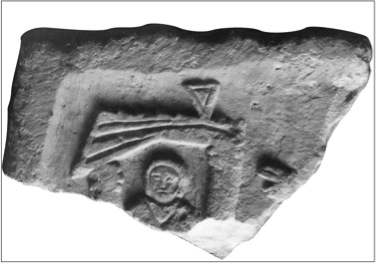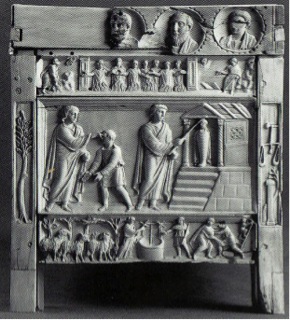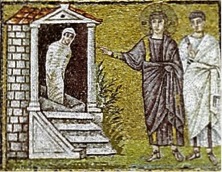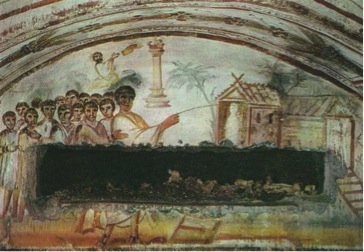Fragment with representation of Saturnino/Lazarus
The archaeological site of San Saturnino is located in the eastern part of the city of Cagliari, an area which in ancient times stood outside the city limits and was part of the necropolis extending east of the town, from today's Viale Regina Margherita up to the Bonaria hill. Here you can still see the surviving evidence of the necropolis and the Basilica dedicated to the martyr Saturnino.
During digs and restorations carried out after the war, the upper left corner of a slab was found, claimed at first to be of marble, but probably of stone; this item can currently not be found, so it is not possible to clarify. Described as the front of a sarcophagus (but may also have been a shelf or a fragment of pluteus), it shows a male figure roughly sculpted under a portico, to the right of which there is a hand in the gesture of blessing (fig. 1): Initially interpreted as S. Saturnino, it is probably part of the resurrection of Lazarus scene, with standard elements: the funeral aedicula indicating the tomb from which Lazarus arose, the deceased in his shroud. Christ carrying out his miracle (figs. 2-4). While with a few details and edges in making the decorative motif, when compared with iconographs, it has been dated to the 4th century, before the age of Theodosius (379-395 A.D.).




Bibliografia
- R. CORONEO, Sarcofagi marmorei del 3.-4. secolo d'importazione ostiense in Sardegna, in R.M. Bonacasa, E. Vitale eds., La cristianizzazione in Italia fra tardoantico e altomedioevo”. Atti del IX Congresso Nazionale di Archeologia Cristiana (Agrigento, 20-25 novembre 2004), Palermo 2007, pp. 1354-1368.
- R. DELOGU, L’architettura del Medioevo in Sardegna, Roma 1953.
- R. DELOGU, Vicende e restauri della basilica di S. Saturno in Cagliari, in Studi sardi, 12-13, 5-32.
- R. MARTORELLI, Le aree funerarie della Sardegna paleocristiana, in P.G. SPANU ed., Insulae Christi: il Cristianesimo primitivo in Sardegna, Corsica, Baleari. Mediterraneo tardoantico e medievale: scavi e ricerche, 16, Cagliari-Oristano 2002, pp. 315-340.
- D. MUREDDU ET ALII, Sancti innumerabiles. Scavi nella Cagliari del Seicento: testimonianze e verifiche, Oristano 1988.
- G. PESCE, Sarcofagi romani di Sardegna, Roma 1957.
- D. SALVI, Cagliari: San Saturnino, le fasi altomedievali, in P. CORRIAS, S. COSENTINO eds., Ai confini dell’Impero. Storia, arte e archeologia della Sardegna bizantina, Cagliari 2002, pp. 225-229.
- D. SALVI, Cagliari: l’area cimiteriale di San Saturnino, in P.G. SPANU ed., Insulae Christi: il Cristianesimo primitivo in Sardegna, Corsica, Baleari. Mediterraneo tardoantico e medievale: scavi e ricerche, 16, Cagliari-Oristano 2002, pp. 215-223.

 VR
VR